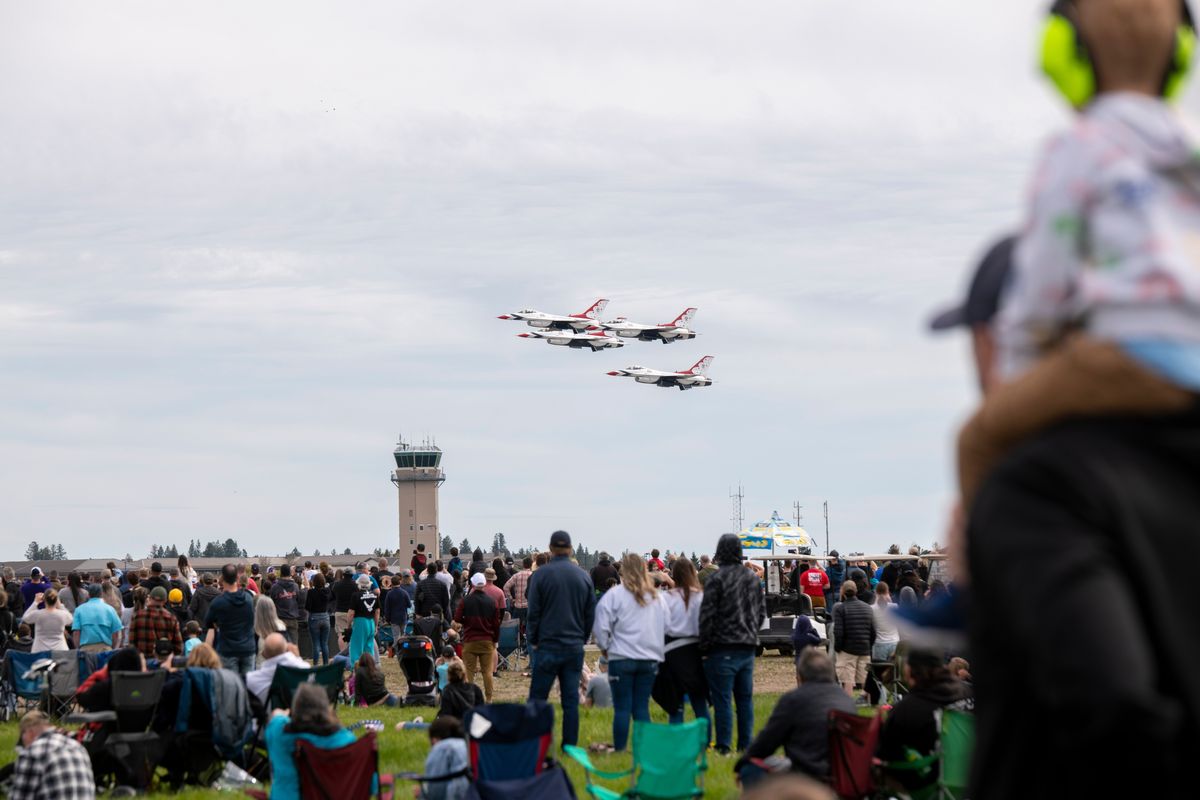Second day of SkyFest brings Thunderbirds, celebration of Fairchild Air Force Base’s history

For all the high-tech entertainment on display Sunday afternoon, Fairchild Air Force Base didn’t forget its history.
Some props for the props, if you will.
The second day of SkyFest offered precision skydiving, midair refueling and the exhilaration of the Thunderbirds streaking above a crowd estimated at more than 100,000.
But this was also Fairchild’s 80th anniversary – the perfect occasion to remember its roots.
Midway through the show, a lone B-25 Mitchell bomber lumbered above the crowd. With a top speed of 270 mph, it seemed to pass in slow motion – all the better to appreciate its history.
In 1942, the year of Fairchild’s founding, crews flying the B-25 undertook the Doolittle Raid, a daring attack on Tokyo that lifted American morale after the Japanese attack on Pearl Harbor.
Earlier in the afternoon, a shiny silver B-29 – one of only two operational models in the world – banked for the cameras as the announcer reminded the crowd that this was the plane that dropped the atomic bombs that helped end World War II.
Few appreciated the moment more than Leo Roundtree of Spokane, an Air Force veteran who served for 26 years, including three at Fairchild.
After snapping a few photos of the B-29, he took a long look around.
“We’ve been to several of these, and it’s great to have it back,” Roundtree said, referring to the event’s cancellation the past two years due to the pandemic.
“For me, this shows off the capability of the Air Force and allows civilians to see how we work, how we live and how we support the United States,” Roundtree said.
Thousands showed their appreciation on a breezy afternoon on the flight line. Families waited in long lines for tours of the interior of a KC-135 refueling tanker.
Andrew Pirochta of Spokane, a former airman, thought it was “pretty cool that I was able to take my kids on a KC-135 that I had worked on. It’s just a great opportunity to see all these airplanes in one place.”
Cody Crouch and Amber Carr of Coeur d’Alene emerged from the same plane with a feeling that it was “pretty cool.”
Crouch and his family were about to exit the plane when they caught sight of another crowd-pleaser: stunt pilot Greg Howard and his G-200 prop plane.
Howard’s signature move was a steep climb, followed by what looked like midair suspension until gravity pulled the nose down and the plane began to descend.
As it did so, “the oohs and ahhs” of the crowd gave way to cheers.
“My heart pretty much stopped,” Carr said after watching from the KC-135. “You get a little bit of anxiety until he starts it back up.”
Others were less worried.
“Absolutely magnificent,” said Bob Poremski, who was visiting from San Antonio. “He’s a great pilot to be able to take that plane and work that precision on the rolls without having the nose falling off.”
But Poremski didn’t travel this far just to watch the air show. His daughter, Maj. Raychel Bates, is in charge of the entire show.
It went flawlessly, at least on the flight line.
It began promptly at noon with a lone parachutist who landed on target. He also landed on cue, during the final bars of the national anthem.
The stunt planes were followed by a static line jump and recovery exercise, a water dump demo by a C-130J, a refueling exercise performed by a KC-135 and the B-25 flight.
By then it was 2:30 p.m. – only 45 minutes before the Thunderbirds were scheduled to perform the finale – and late-arriving fans were outside the gate. Others were still in their cars on Highway 2.
That shouldn’t have been a surprise. This was Spokane’s first SkyFest since 2019, and clearly the event was missed. On top of that, inclement weather on Saturday held the crowd to a tepid 25,000, while low cloud cover forced the Thunderbirds to cancel.
Clearly there was some pent-up demand to see the Thunderbirds. First Lt. Michelle Chang, the base’s public information officer, said the crowd was “over 100,000.”
By the time the six pilots climbed into their cockpits, thousands were still pressing to move through security. All were able to catch at least some of the finale.
For almost 45 minutes, the six F-16C Fighting Falcons roared above the crowd. They flew in close formation – inches apart, it seemed from the ground – then shot off in six directions accompanied by the roar of engines and the crowd.
As one late-arriving fan cleared the security and began to walk toward the flight line, a single Thunderbird roared past at low altitude.
The man paused and looked up, astonished.
“Well that was worth it,” he said.